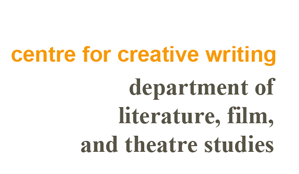Military Falcons
Helen MacDonald
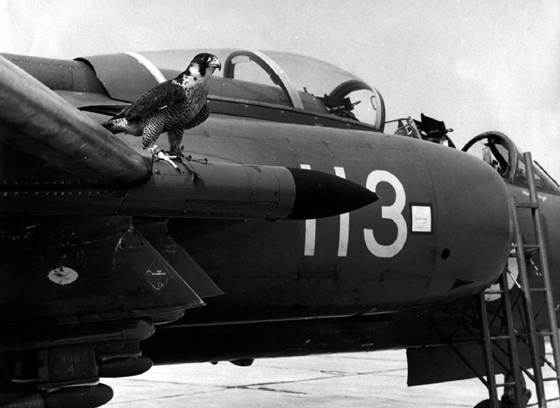
It is 1967, and a trained peregrine stands to attention on the ARI8228 passive warning radar of a Blackburn Buccaneer. Poised on this powerful low-level British nuclear bomber, she looks ready for flight. Head haloed within the curve of the open canopy, eyes scanning the far horizon for possible targets, the bird's form irresistibly mirrors the plane—and she's a neat symbolic stand-in for the absent pilot: even her facial markings suggest a flight helmet. What is happening here? Is this merely one recent manifestation of an association between falcons and warfare that spans centuries and cultures, a snapshot resolving itself from history?
It might seem so. Russian ornithologist Dementiev described an ancient "oriental proverb" that 'falconry is the sister of war'1. Eighth-century Turkic warriors were thought to become gyrfalcons after they died in combat; Chingis Khan disguised his armies as hawking parties, and fifth-century Chinese falcons carried military messages tied to their tails. And falconry trained military men as well as birds: sixteenth-century Samurai manuals had a falconry section, and falconry was a component of the education of the medieval European knight. Thought to foster chivalric qualities and to hone tactical skills for battle, similar virtues for falconry are still appealed to today: falconer and author Nick Fox suggests that the qualities of strategic thinking one develops as a falconer gives one the edge in—one would hope less bloody—boardroom battles. The list continues: seventeenth-century English royalists battled parliamentarian troops with two-and-a-half pound Falcon cannons. Three centuries later the US Air Force named their guided quarter-kiloton nuclear-armed air-to-air missile the AIM-26 Falcon. A 1946 American book catalogue described peregrine eggs as 'atomic bombs'—a heartrendingly ironic metaphor, for those eggs were doubtless contaminated by bioaccumulated DDT pesticides as invisible and deadly as fallout.
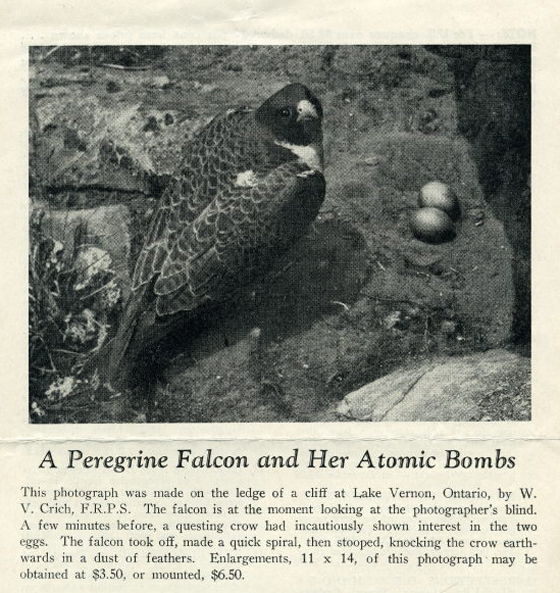
But this Buccaneer falcon is not a mascot. It is a live bird recapitulating the aircraft's role, a bird literally weaponised. An integral part of British air defence systems, its task is to defend the aircraft by targeting its potential destroyers—gulls. Ever since the US built an airbase in the middle of an albatross colony on Midway Island in the 1940s, ornithology has been a branch of military science. A single bird sucked into a jet intake or flung through a canopy can destroy a plane as spectacularly as can an air-to-air missile. On Midway the US Navy hit upon radical habitat management as a solution. They paved most of the island. Albatrosses don't nest on concrete.
But the problem is not limited to the Pacific theater: airfield grass everywhere attracts flocking birds such as starlings and gulls. Shooting them or scaring them with vehicles doesn't clear a runway and its associated airspace in seconds: but falcons do. Enter the cavalry. The falcon on the buccaneer is from a Navy falconry unit stationed at Royal Naval Air Station Lossiemouth in Scotland. Initiated by falconer Philip Glasier, the team won its wings with a 'live-fire' demonstration to a group of officers, reporters and photographers. Clustering expectantly at the flightline, the naval officers were dubious. They were unconvinced that falcons could safely clear duty runways, and 'did not fancy having a bunch of crazy falconers let loose on their airfield'.2 But Glasier's demonstration was flawless. Cast off at a flock of herring gulls sitting on the runway, the falcon made the gulls clear the horizon in seconds, all save for one luckless laggard she pulled from the sky.
Today, similar airfield bird-clearance units operate worldwide. The media loves their glamour; for the public they are a 'greener', more acceptable bird-control method than shotguns. And the military loves them too, for falconry units powerfully naturalize the ideology of military airpower. The unspoken argument runs as follows: if the military can demonstrate that natural falcon behaviour is the biological equivalent of tactical air warfare, then who can possibly see tacair as wrong? It's natural. This is a crafty move, and we buy into it wholesale. If we didn't, that peregrine sitting on the Buccaneer would look incongruous. The naturalisation works in part because war and nature are traditionally assumed to be utterly separate realms. 'War' wrote Karl von Clausewitz, 'is a form of human intercourse'.3 But the strange history of military falcons shows, by turns bewilderingly, amusingly and horrifyingly, that the traditional supposition that war and nature are utterly separate realms is a lie.
Keep US interventionist foreign policy in mind when reading the words of a bird-clearance contractor at March Air Reserve Base, California. 'Wherever the falcons fly, that area becomes their territory' he explained in Citizen Airman magazine in 1996. 'In the bird kingdom' he continues, 'boundaries are taken very seriously. It's life or death'.4 Troubling. For these falcons are not behaving territorially, of course. They are not protecting their territory from intruders. They are hunting. What's more, these confusions point to something about the nature of science, for the concept of bird territory itself has a military history. It was first described by British ornithologist Eliot Howard just after World War I had decisively established the bloody realities of international territoriality on a grand scale. And in a rather less subtle naturalisation of tactical air warfare in the late 1990s, the owner of the bird-clearance project at March Air Reserve Base explained earnestly that 'just as the US puts an aircraft carrier off Iraq and flies fighter sorties to establish airspace dominance, our falcons do the same thing'.5
But how same? Is a falcon a fighter jet? Both are conceived of as pushing the outside of the envelope of physical possibility; both are often considered perfectly evolved objects in which form and function mesh so precisely there is no room for redundancy. The falcon has long been the embodied shape of aviation's dreams of the future. Back in the 1920s, Pennsylvania falconer Morgan Berthrong recalls an aviation engineer admiring a trained peregrine above, her wings pulled back into a sharp delta shape as she glided into a stiff headwind. 'See that silhouette?' exclaimed the engineer. 'When we develop a motor strong enough, that will be the shape of an airplane'.6 And yes, General Dynamics' F-16 'Fighting Falcon' was named after the bird, and there are stories that the aeronautical engineers put peregrines through their paces in wind tunnels while designing the plane. Such tales may be apocryphal, but their continuance bespeaks an urge to show the plane as a more-than-material object whose function and form are as highly evolved as that of its natural exemplar, the falcon. 'If it looks right, it flies right' runs the test pilots' dictum. And warbird homologies have been loaded with serious ideological weight. Kansas-based organisation 'Intelligent Design' uses the plane-peregrine example to support the theory that intelligent causes are responsible for the origin of life and the universe.
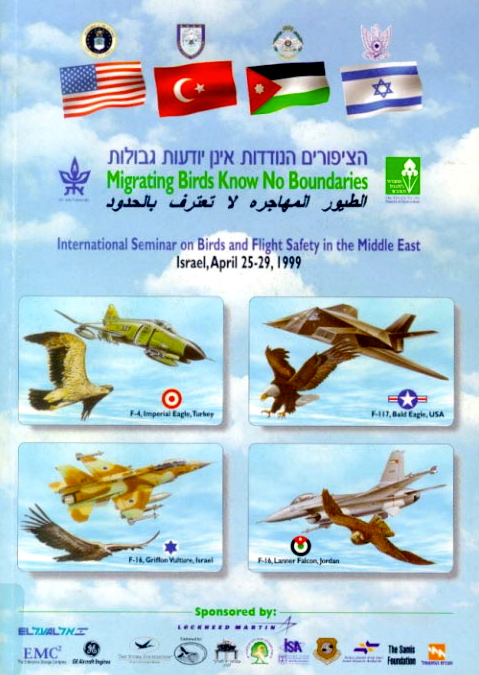
Mobilising falcons
Twentieth-century falcons have been tasked with military roles far beyond airfield-clearance or martial symbolism. WWII mobilised falcons too; and they flew for both sides. Allied planes carried a box of homing pigeons to be released if they were shot down behind enemy lines. There was a problem, however: wild English peregrines were catching and eating the pigeons after they’d crossed the Channel. Alarmed, the Air Ministry ordered that these quisling falcons on the south coast should be destroyed. Between 1940 and 1946, around 600 were shot, many eggs broken and young killed. Yet, at the same time, allied peregrines were 'signed up'. Falconer Ronald Stevens was convinced that falcons could be used in the war—somehow. He'd heard that in 1870, trained German falcons had been used to intercept the French Pigeon Post in the siege of Paris. Stevens quickly set to work. With a friend, he built a miniature range. 'On it' he explained, 'we put a ring of falconers round a besieged city, we covered a salient, we put a "net" of falconers behind enemy lines and in fact disposed falconers in every way we could think of'.7 Excited by the prospects, he sent photographs of the models, along with extensive logistical analyses, to the Air Ministry.
Stevens must have been terribly persuasive, for a top-secret falcon squadron was recruited, trained, and scrambled to patrol the skies above the Scilly Isles, near Keyhaven, and on the East Coast between 1941 and 1943. A biological addendum to the top-secret chain of Key Home radar stations ringing the coastline, its mission was to intercept 'enemy pigeons' released from German E-boats or the like. An exclusive on the secret project later appeared in the American press. 'Operations by friendly birds were controlled just like airplanes so they knew where every bird was all of the time' it enthusiastically explained. 'Falcons were taught to fly at great heights and to fly in circles like an aircraft on patrol duty […] a falling trail of feathers meant another dead Nazi bird'.8 What wasn't revealed was that the practical results of the operation were almost nil. While many pigeons were killed and one or two captured alive, only two carried messages. An RAF commander dryly related the fate of one pigeon POW—put to work 'making British pigeons' in a Ministry of Defence pigeonloft. But successful or not, it didn't really seem to matter. The peregrines kept flying. Officers from Intelligence, the Royal Corps of Signals and the Air Force frequented the unit to watch 'thrilling' demonstration flights, and 'were most impressed with the hawks' performance.'9 Of course they were. Falcons were fast, manoeuvrable, their prey outflown, out-armed and despatched with a winning 'cleanness', naturalising the ideology of honourable combat. Falcons were a moral predator. A sportsman. In 1948 Frank Illingworth recalled a cliff-top peregrine-watching session. 'Mock battles are best demonstrated by two wild peregrines in playful mood' he wrote, before continuing:
the profusion of winged movement which we watched that pre-war morning rivalled anything I saw in the same skies during the Battle of Britain… a few sharp wingbeats, a few chattering cries suggesting staccato machine-gun fire, and the tiercel 'fell away' like a black dive bomber […] Here were two superb fighting machines indulging in mock battle for the sheer joy of movement.10
In such passages, airpower evangelism meets falcon in the historical consciousness of the Romantic Right, for from the dawn of the air-age, a strand of thought had seen the fighter pilot as an aristocrat pitting his skill and courage in single combat with a worthy opponent, high above the messy realities of infantry and mud. Aerial combat was commonly conceived of as a throwback to an age of chivalry, the pilots as 'knights of the air'. Such dreams are beautifully articulated in the opening of Powell and Pressburger's 1942 film A Canterbury Tale. Powell saw the film as a crusade against materialism, a paean to English historical continuity and to the eternal nature of spiritual values. It opens with a recitation—incidentally, by falconer Philip Glasier’s cousin Esmond Knight—of the Prologue to The Canterbury Tales.
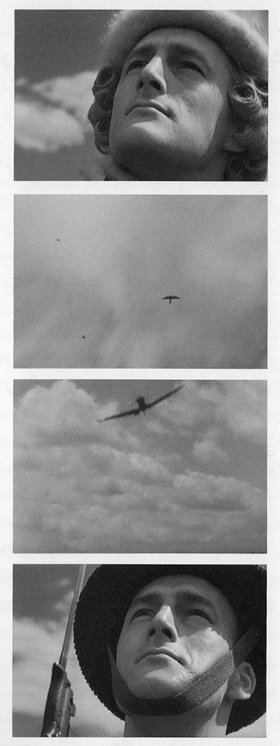
Tracing a map of the medieval pilgrim's route, the screen dissolves to a scene of Chaucer's pilgrims riding along the high downland paths to Canterbury. A falconer unhoods and casts off his falcon. His upturned face is followed by footage of the falcon in flight, its flickering wings a drawn bow against the grey Kentish skies. A sharp cut that prefigures Kubrick's famous bone-to-spaceship cut in 2001: A Space Odyssey by twenty years, and the falcon is transformed into a diving spitfire. We return to the upturned face of the falconer—who is now a soldier watching the plane above—and instead of a line of medieval pilgrims, a military exercise crosses the downs toward Canterbury. The conflation of falcon-as-military-aircraft with falcon as symbol of a mythical English past enabled its image to powerfully connect the idea of the nation's heritage with its recent defence through aerial battles; an essential, continuous national identity recoverable through the image of a bird.
While A Canterbury Tale attempted to show wartime Americans why they should defend Britain, in the USA the weaponisation of falcons was assuming bizarre forms. 'Real Warbirds for Uncle Sam' ran the headline in the American Weekly in 1941. 'If the Time Comes When They Are Needed, the Fighting Falcon and the High-Flying Eagle May Take the Air to Put the Enemy's Homing Pigeons Out of Action'. It continued:
While the nation's airplane factories are busy turning out bombers and fighters for Uncle Sam's growing air armada, the officers of the Army's Signal Corps [...] are thinking seriously of pressing another type of warbird into service. Known to the military mind as 'the original dive-bombers' […] two or three hundred falcons will be trained at Fort Monmouth under direction of Lt. Thomas MacClure, of the pigeon-training center.11
With his assistants, Privates Louis Halle and Irwin Saltz, MacClure aimed to 'reinforce the falcon's natural armament with razor-sharp knives attached to the talons, wings and body' Not only would these trained birds be used to kill enemy carrier pigeons and take 'the dead messengers and their message to headquarters', but 'the Army believes further that the falcons can be taught to dive at enemy parachutes and either rip them or cut the cords'.12 He explained in The New Yorker that although retrieving prey to the falconer was unheard of in traditional falconry, orthodoxy was not to stand in the way of efficiency. 'War is different from falconry' he stated firmly.13 McClure sent out letters soliciting donations of falcons and held a publicity talk, complete with hooded falcons, in Times Square. His rousing call did not impress one of the onlookers, the falconer George Goodwin. Goodwin was the curator of mammology at the New York Museum of Natural History. He was appalled. 'If McClure is a sample of the Army, thank God we have a Navy!' he wrote in high dudgeon to a friend:
'Did you know that the Army has developed a method of teaching peregrines to distinguish between their own pigeons and the enemy's? Well it has but that's a Military Secret that cannot be divulged! Hallelujah! ….it drives me nuts just to think of it. I'm glad to have some first hand information on the Pigeon Blitz Patrol and on McClure, but I wish to hell I hadn't seen the show they put on. I'm scared to go to sleep now for fear I'll wake up dreaming about it'.14
Other US falconers sprang into action 'Something must be done' wrote anatomy professor Robert Stabler to the chief of the US Fish and Wildlife Service. 'Can't you give this man and his group something of an investigation? Is there no limit to what a man may do under the guise of defending America?'15 And falconer and Army aviator Colonel Luff Meredith took immediate steps at the War Department to ensure that McClure’s program never got off the ground.
Meredith recruited falcons into the military in a far subtler fashion than McClure: no Times Square event was required. He was a friend of General Harmon, who was to head the newly created US Air Force Academy in Colorado Springs. A few years after the end of WWII, recalled Robert Stabler, he and Meredith 'grabbed a couple of peregrines, hopped in Meredith's Jaguar' and drove down to Lowry Air Force Base; Meredith was convinced the Air Force needed the peregrine falcon as its mascot. Harmon 'had us to lunch and we had the peregrines sitting on the back of a chair—Mrs Harmon there—we put newspapers on the floor'. Harmon sent them over to show the birds to General Stillwell and Colonel Heiberg; they 'picked up the birds and became immediately consumed with the peregrine'. Stabler remembers Stillwell saying:
'well we will certainly present this bird as one of the things'... I think they were considering a tiger and a hawk of some kind and so on. "So we'll present a peregrine and so on to the Cadet wings and let them vote on what they want". And they did that in the next 2 or 3 days and they voted on the peregrine as being the mascot of the Air Force.16
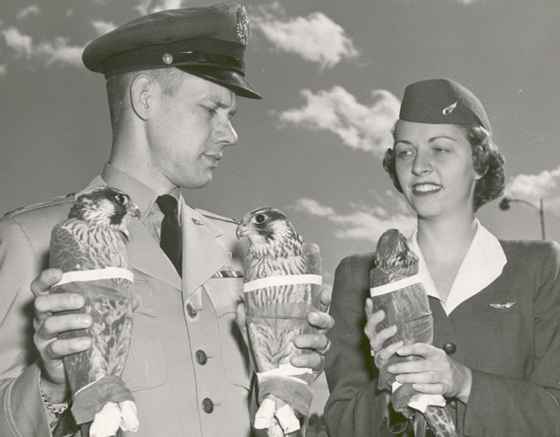
On election day, the officer lobbying for the falcon succinctly concluded his speech: 'the falcon has a speed in level flight of approximately 165mph. Its dive speed is classified information. The golden eagle is a scavenger! You will now vote.'17 Thus on 5 October 1955 the first mascots duly arrived at the Academy. Held aloft for the Air Force photographer, and swaddled and bound to prevent injury en route, they look as bemused as their uniformed couriers.
Since 1956 falcons have been flown at Academy football games in half-time demonstrations of airpower dominance. The USAFA website explains how falcons characterise the combat role of the US Air Force: they are fast and 'manoeuvre with ease, grace and evident enjoyment'. Courageous, fearless and aggressive, they 'fiercely defend their nest and young against intruders. They have been known to unhesitatingly attack and kill prey more than twice their size'. And of course, along with their keen eyesight, they are marked by their 'alertness, regal carriage and noble tradition'.18 With a nod to Tom Wolfe, US military falcons are The Right Stuff.
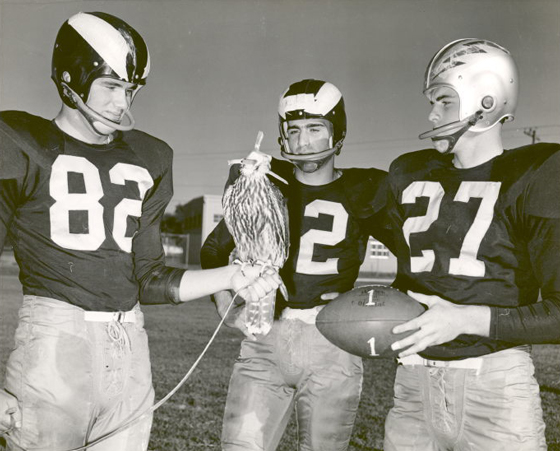
Hungry and Mr Galileo
And with almost inevitable logic, USAF falcons have made it to the moon. In July 1971, standing by Apollo 15's Falcon landing module, Commander David Scott grasps a feather from a USAFA mascot prairie falcon called 'Hungry' in one gloved hand and a geological hammer in the other. Unrecorded by stills camera, this episode exists only as blurred video footage, a strange, charged mix of science and popular entertainment. Scott's voice breaks enthusiastically through the white noise of the lunar transmission:
One of the reasons we got here today was because of a gentleman named Galileo a long time ago, who made a rather significant discovery about falling objects in gravity fields. […] The feather happens to be appropriately a falcon feather, for our Falcon, and I'll drop the two here, and hopefully they'll hit the ground at the same time...19
They fall in tandem to the surface of the moon. Pause. 'This proves that Mr. Galileo was correct in his findings' Scott announces. Wondrous symbolism: rather than a hammer and sickle, here is a hammer and an American falcon feather, bathed in stark sunshine through an auratic haze of lunar dust.
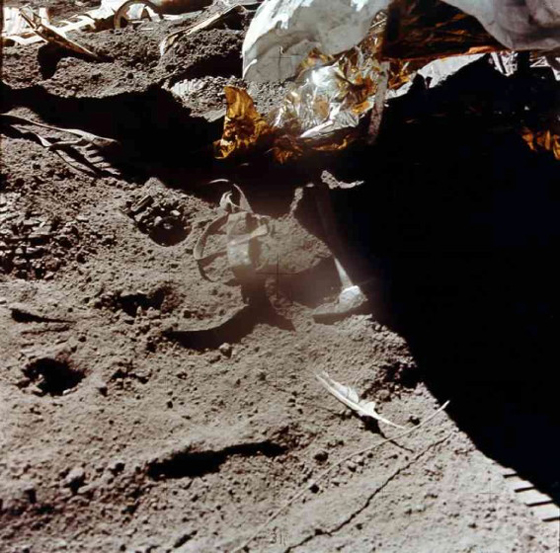
Scott's recapitulation of a crucial experiment is broadcast as the summation of science's triumph in the conquest of space—America claiming the right to prove the laws of nature. And training a hawk can prove one's patriotism, too. 'In the final analysis' earnestly explains cadet falconer Cadet Peterson, the US Air Force Academy's falcons 'don't have to impress us, we've got to prove to them that we are worthy of their trust.'20
Fittingly for a bird so meshed with national and martial iconographies, twentieth-century falcon stories are rich with espionage. Sometimes it's merely literary: in The Hooded Hawk Mystery, the Hardy Boys' peregrine foils a gem-smuggling ring by slaying ruby-carrying racing pigeons. And Hasbro Toys' 2000 Falcon Attak Action Man comes with a natty fringed leather arm-brace and a surveilling cyber-falcon you can launch across the room. Sometimes it's real, and just as peculiar. Back in 1940 a New York Times headline ran:
HINTS AT GOERING AIM IN VISITING GREENLAND: EX-AIR CORPS PILOT SUSPECTS A PURPOSE BEYOND FALCONRY.
Below it, Captain Meredith suggested that 'now Germany has taken Denmark, considerable significance might be attached to the 'falcon expedition' sent by Field Marshal Hermann Goering to Greenland in 1938'. 'To be sure' he remarked drily,
Field Marshal Goering is, like myself, an amateur falconer, but at a time when Germany was undergoing such economic and political changes one wonders why he would go to all the trouble and expense just to get six Gyrfalcons. Five members of the expedition spent almost six months in Greenland, and during that time they could not have escaped a lot of general, and perhaps specific, observations.21
Strange symmetries existed: General Goering and Air Marshal Sir Charles Portal, commanders-in-chief of Luftwaffe and RAF respectively, were keen falconers both. So was the most infamous American spy of the 1970s, Christopher Boyce. Boyce worked at US spy satellite manufacturer TRW, where his extra-curricular activities included flying falcons in the California hills, making daiquiris in the top-secret-document shredder, and selling secret spy-satellite information to the Soviet Union under his nom de plume 'The Falcon'. Boyce was played by Timothy Hutton in John Schlesinger's 1985 film The Falcon and the Snowman. Schlesinger leans heavily on the familiar falcon symbolism, bringing the camera in to linger on the dark eyes of the peregrine as FBI agents close in to arrest Boyce: grand motifs of freedom, infinite vision and mastery of the sky.
Falcon 2020
But surely, one might ask, what about eagles? Wasn't it an eagle that Roman centurions carried on their battle standards, the eagle on the seal of the United States, or the German and Austro-Hungarian flags? Agreed: but these eagles map to nation-states, not to modern war. Eagles are large, impressive, powerful. They connote old-fashioned styles of warfare: huge armies, large-scale infantry movements, and massive and deliberate strength. Falcons, however, are small. They possess immense speed, mobility and range. Falcons, not eagles, are the iconic animals of post-modern, network-centric war, built on the concepts of global vision, surveillance, rapid deployment and lighting strike. They allow a naturalisation of what cultural commentator Paul Virilio describes as 'pure' weapons, weapons whose destructive capability is a function not of their massive power, but 'the rapidity and extreme precision of [their] delivery—and this as much in the sighting or surveillance of enemy movements as in the selectiveness and stealth of the strike'22.
In blue-sky documents such as Joint Vision 2020 23 the US military dreams of future battlefields. A digitised world, a seamless integration of biological units—soldiers, pilots and so on—with high technology. Military superiority is built on knowing where everything is, coupled with the ability to intervene in near real-time. Drenched in the terminology of complexity and air-power theory, it is a dream somewhat sullied by recent events in Iraq; winning a battle is different from strategic victory. Built on speed and omniscience, C4iSR is the preferred acronym for this metaphysical mix: Command, Control, Communications, Computers, Intelligence, Surveillance and Reconnaissance. Such is the fearsome hunger of this dream of digitised war that these military networks extend out beyond the merely human and beyond the exigencies of landscape to incorporate animals too. The idea of incorporating wild animals into military surveillance networks for conservation ends was first mooted in America in 1966 at a NASA-sponsored wildlife conference. Speakers Frank and John Craighead were no longer excited teenage falconer-photographers: they were now eminent wildlife biologists and ex-field-intelligence operatives who'd authored the US Navy's WWII survival guide. Satellites could be used to track wildlife movements, they suggested. Perhaps one could integrate wildlife-tracking data with Landsat imagery or spy-photographs from the USAF/CIA U-2 surveillance programme. Their paper was prescient.
One champion of the peregrine during the DDT years was F. Prescott Ward, a falconer and chemical and biological warfare expert who was an ecologist at the US Army's chemical weapons testing ground in Maryland. He helped the Peregrine Fund organise a spectacularly successful release of young peregrines from an old chemical-shell testing gantry. Swords to ploughshares. But Ward had bigger plans: a large-scale study of the migratory habits of the tundra peregrine. These beautiful, pale, diminutive peregrines congregated on east-coast beaches on their way southwards in the fall. So tame you could practically walk up and touch them, they'd been trapped by falconers for years. Falconer-trappers like Alva Nye and Jim Rice knew these falcons bred in the far north, and wintered in the south. But no one knew exactly where, or the routes they took. But what had been a wistful conundrum in the 1930s and 1940s became an important question in the post-DDT era. For while DDT had been banned in the continental United States, it was still used further south. These migratory populations were still threatened.
And so Ward and his co-workers on the project trapped and banded migrating peregrines on the east coast; other falcon-minded researchers, like arctic specialist William Mattox, who was central in instigating the Greenland Peregrine Falcon Survey in 1972, banded falcons far further north. Others went south, hoping to spot wintering peregrines. Overall the project was as politically fascinating as it was biologically; it involved international agreements signed by the US/USSR Working Group on Wildlife, and White House staff joined the research team. But politics were no help in re-encountering banded falcons: this required luck, and the resulting migration data sets were inevitably sparse. What everyone really wanted, of course, was to capture the entire spatio-temporal pattern of a migration. So, after experimenting with falcon-mounted radiotransmitters tracked from light aircraft, the idea of miniature backpack-mounted satellite tags was mooted.
One-kilo satellite transmitters had already been produced by the 1980s. Splendid for tracking polar bears and caribou but clearly a little impractical for birds. Joint military–university research soon triumphed, however, with a new generation of miniature satellite transmitters. Known as Satellite Platform Transmitter Terminals (PTTs), they initially weighed around 200g—swan and goose-sized birds alone could carry them. They now weigh less than 20g. The PTT is mounted on the bird's back using a soft, carefully designed, temporary harness. And then the bird is released: its location determined remotely from the Doppler shift in the carrier frequency transmitted by the tag as the receiving satellite passes overhead. Service Argos, the French operated sensor system carried on NOAA weather satellites, picks up the signals, and calculations of the bird's position are conducted at data processing centres in France and Maryland – and the Air Force Space Command tracking facility in Colorado provides orbital elements for each satellite.
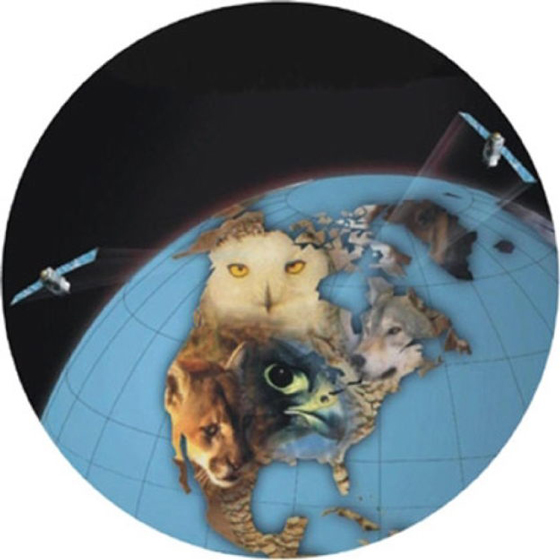
In God we Trust: All Others we Monitor 24
The peregrine migration study rolled into the 21st century under the aegis of the US Department of Defense's 'Partners in Flight' program, and the private/ university/government partnership, the Centre for Conservation Research and Technology (CCRT). The Department of Defense is the third largest landowner in the US and is legally obliged to protect endangered animals on its land. Proving grounds and missile-testing ranges are not optimal habitats for roving field biologists, so remotely tracking animals by satellite or radio is a practical solution. Yet monitoring animals in this way has ideological benefits for the US military, too. Back in the 1940s Aldo Leopold introduced the notion of the 'land mechanism' in ecology, metaphorising ecosystems as complex engines of cogs and wheels. It was a conception of nature fitted to the discourse of technocratic militarism. CCRT biologists describe satellite tagged peregrines as 'taste-testers' discovering 'hot spots along their route of dangerous pesticides and other threats to survival'.25 Here the falcon is a biological probe sent out to assess the environment, a hybrid of Predator UAV and miner's canary. And satellite-tagged peregrines are more than mere monitoring instruments. CCRT biologist Tom Maechtle mused on how satellite tracking 'turns the animal into a partner with the researcher'. 'You can think of a peregrine as a biologist who has been sent out to find and sample other birds' he explains.26
Maechtle's words are familiar: once again, here is a falcon biologist identifying strongly with his subject, just as the Craigheads saw their young, adventurous field-biologist selves mirrored in the eyes of the peregrine. And Los Angeles Times science writer Robert Lee Hotz is at pains to point out that this new kind of science doesn't threaten the old ways. Not all modern biologists stare at computer screens under fluorescent strip-lights, listening to the hum of climate control instead of birdsong. 'Despite these advanced tracking technologies' he writes, 'the biologists... still must catch the birds by hand'.27 The social identity of the adventurous field-biologist is unthreatened by satellite tracking. Stamina, field-craft, practical skills: these are all still required. And thus, high technology and global vision are linked with individual heroism and the soul of the wild frontier.
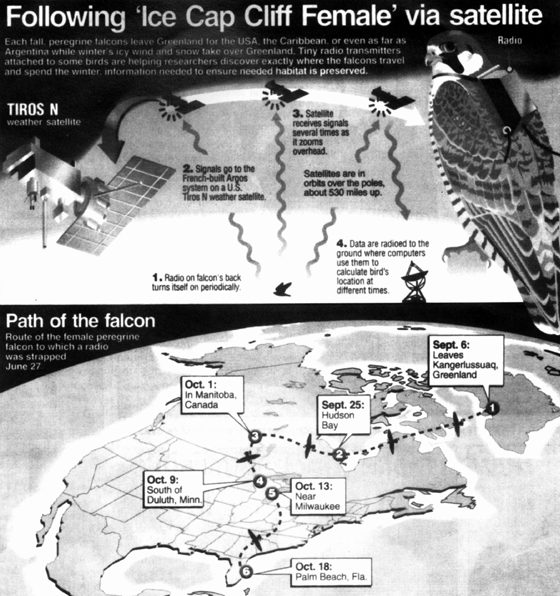
A heady mix. For while their conservation benefit is unarguable, the inner logic of these defense-funded tracking efforts is breathtaking. As each individuated falcon is tracked across global space, it carries far more than simply its location. CCRT calls the tagged bird a 'sentinel animal'. Each symbolically extends US technological and military dominance even as it offers myths of 'one world' environmentalism: global surveillance systems track 'American' falcons as they penetrate airspace as far south as Buenos Aires and the headwaters of the Amazon Secondly, these augmented falcons join together two incommensurable worlds—those of military/war, and nature/peace. These concepts seem naturally opposed, but the satellite-tagged falcon closes the divide. The myth of falcon-as-warplane meets the myth of falcon as unparalleled symbol of wild nature, the tagged falcon a halfway house between the two systems of nature and culture, between national defence and the defence of national nature. One might see the satellite-tagged falcon as an ultimate naturalisation for the military, which not only defends nature, but also promotes the notion of an ecosystem as just another complex technological system, something entirely integratable into C4iSR systems.
A new generation of bird-borne PTTs will carry advanced sensors to detect speed, temperature, humidity and atmospheric pressure, digital audio capture systems and even miniature video cameras. Sound familiar? Over the past few years, developments in US military unmanned aerial systems have produced tiny Kevlar and carbon military drones that hover or fly hundreds of feet above the battlefield, tracking military vehicles and sending live video feeds to the laptops of unit commanders. And in Idaho military training grounds, CCRT has satellite-tracked raptors in conjunction with the Deployable-Force-on-Force Instrumented Range System (DFIRST) to demonstrate the feasibility of integrating automated military tracking systems with natural resource management technology, simultaneously tracking the movement of raptors and military vehicles. The bird is tracked as an object in a system of objects. And those other objects happen to be military.
Indeed, in Alaska, the US Air Force has designated peregrine nests as surface-to-air missile sites. 'By designating known nests as simulated 'threat emitter sites (areas that pilots must avoid as part of their routine training program)' reports explain, 'the Air Force has continued realistic training while simultaneously protecting nesting peregrine falcons. This species is now recovered'.28 The wording is highly ambiguous, suggesting that by including peregrine nests on tacair training maps, the USAF has defended and saved the peregrine. In terms of one particular strand of falcon iconography, that might well be true. Nature and the Military achieve a discursive equality—they become symbolically equal when their positions are read through battle software, on a battle-map. Defending the falcon is defending the nation. Attila would have been proud.
Notes
1 G.P. Dementiev, The Gyrfalcon (Moscow, 1960).
2 Philip Glasier, Falconry and Hawking (London, 1978), p.163.
3 Karl von Clausewitx, On War (trans. O. J. Matthijs Jollis), (Washington, 1953), p. 5.
4 Master Sgt. Patrick E. Clarke, 'Bye-bye Birdies: March looking at adding falcons to its arsenal of bird strike weapons', Citizen Airman Magazine.
5 Op. cit.
6 Morgan Berthrong, Oral History interview with S. Kent Carnie, 1990. Transcript, Archives of American Falconry, p. 22.
7 Ronald Stevens 'How Trained Hawks were used in the War'. The Falconer, 2 (1) (1948), pp. 6-9.
8 Associated Press report, n.d. Archives of American Falconry file 86-2 (correspondence, R. Stabler).
9 Ronald Stevens (1948) 'How Trained Hawks were used in the War'. The Falconer, 2 (1), 6-9. (9).
10 Frank Illingworth (1949) Falcons and Falconry. London, pp. 23-24.
11 The American Weekly n.d. c. 1941. Archives of American Falconry.
12 John E. Bierck, '"Dive-Bombing" Falcons to Play War Role Under Army Program'. New York Herald Tribune, 1941, n.d. Archives of American Falconry.
13 Anonymous, 'Falcons on Duty', The New Yorker, August 30, 1941, pp. 9-10. (9).
14 Letter from Bill Sargent to Robert Stabler, August 30, 1941. Archives of American Falconry.
15 Letter from Robert Stabler to Mr Frederick C. Lincoln, Chief, FWS, Dept of the Interior, Washington DC. 26 August 1941, Archives of American Falconry.
16 Interview with Robert M. Stabler by J.K. Cleaver, dated March 4, 1983, Archives of American Falconry, p. 22.
17 Anonymous, 'A Bird in Hand'. The Monitor, 46(2), pp. 16-17, (March 1956), p. 16.
18 United States Air Force Fact Sheet: The Falcon.
19 Apollo 15 Lunar Surface Journal, 'The Hammer and the Feather' http://history.nasa.gov/alsj/a15/a15.clsout3.html
20 USAF Cadet Peterson, quoted in: Sam West, 'Falconry: Power, Grace and Mutual Trust' The Air Force Football Magazine, October 2, 1965, 4-5, 36-39, (39).
21 'Hints at Goering Aim in Visiting Greenland. Ex-Air Corps Pilot Suspects a Purpose Beyond Falconry', New York Times (14 April 1940) p. 41.
22 Paul Virilio, A Landscape of Events, trans. Julie Rose, (Cambridge MA, 2000), p.28.
23 Joint Vision 2020. Available at: http://www.dtic.mil/jointvision/
24 Motto of United States Air Force 5th Reconnaissance Squadron.
25 Rocky Barker 'BSU Scientists use Transmitters to Track Falcons'. The Idaho Statesman, reprinted in Center for Conservation Research & Technology (CCRT) Recent Media Coverage of Field Research Efforts.
26 (Rocky Barker) 'BSU Scientists use Transmitters to Track Falcons', Idaho Statesman, reprinted in CCRT Recent Media Coverage of Field Research Efforts.
27 Robert Lee Hotz 'Spying on Falcons from Space', Los Angeles Times, Tuesday 14 October 1997.
28 US Department of Defense and US Fish and Wildlife Service. Protecting Endangered Species on Military Lands. (2002)
About the article
Military Falcons
Military Falcons is an extract from the book Falcon, which appeared in 2006 in the Reaktion series, 'Animals', and draws on Helen McDonald's experiences at home and farther afield with the ancient art of falconry and with the birds themselves, several of whom she has trained.
About the author
Helen MacDonald
Helen Macdonald is a poet, a historian of literature and science, and a falconer. Her poems have been published in Shaler's Fish (2001), and several magazines and website; her Radio 4 Afternoon Play, The Falcon and the Hawk, adapted J.A Baker's book The Peregrine, combining it with her own experiences as a falconer. She is now writing H Is For Hawk, to be published by Jonathan Cape. She says of her book, 'It is partly a diary of training a large and powerful bird of prey, and partly the record of a spiritual journey - an unflinchingly honest account of my own struggle with grief during the difficult process of the hawk's taming, and my own untaming. It is the story of a journey into wildness with a creature that almost brought disaster, but was also my salvation. The book is also a meditation on the place that hawks have had in the human imagination for millennia, the place of nature in the modern world, and the strange story of another falconer, goshawk-keeper and writer, the novelist T.H. White, best known for his series of Arthurian books The Once and Future King.'
Helen is currently an affiliate research scholar at the Department of History of Philosophy and Science at Cambridge, where she is continuing her exploration of the connections between the history of ecology and conservation, natural history writing, and field-sports and hunting cultures in the 20th century. Through different ways of writing, she is continually inquiring into the entanglements of humans with birds, as these selected poems, and this extract from her earlier book Falcon show, the ways war and nature have been yoked, and is extending that interest into the history of biological warfare.


